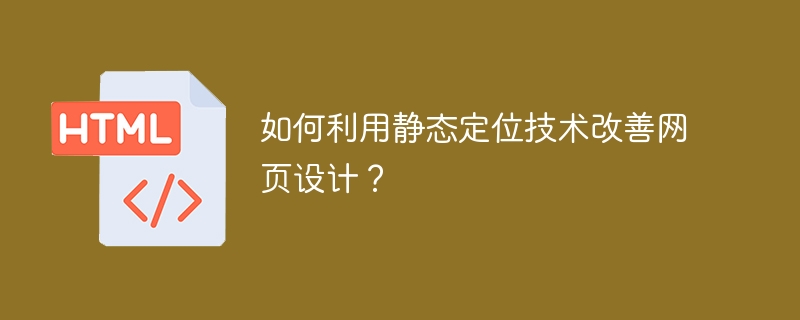

In the modern Internet field, web design is a crucial field. Delving deeper into all aspects of web design, modern designers are increasingly aware of the importance of static positioning technology. Static positioning technology can make web design more flexible and more in line with user needs, thereby greatly improving user satisfaction and experience with web pages. This article will explore the role of static positioning technology and how to optimize and apply static positioning technology in web design.
1. What is static positioning technology?
Static positioning technology controls the position and size of web page layout through CSS. Its main feature is that the spatial relationship between all elements is fixed, that is, no matter how the browser window size changes, all elements will be positioned according to certain rules and their positions will remain unchanged. This is different from dynamic positioning technology, which adjusts the position and size of elements in real time while the user is browsing.
Static positioning technology is divided into four types: absolute positioning, relative positioning, fixed positioning and static positioning. Absolute positioning places an element at a coordinate point on the page and does not move as the page scrolls. It can be adjusted through the top, right, bottom and left attributes. Relative positioning is adjusted relative to the position of the element in the document flow. The element maintains its original position in the document flow, but does not affect the position of other elements. Fixed positioning is to fix the position of an element on the page. No matter how the page is scrolled, the position of the element will not change. Static positioning is the default position of an element on a web page without any adjustments.
2. The role of static positioning technology in web design
Static positioning technology mainly plays a role in web page layout and typesetting. The main purpose of web page layout is to achieve the combination of web page content and web page design, and to combine visual design with web page content to achieve visual beauty and comfort. Static positioning technology can help designers better implement web page layout and typesetting, and thus obtain a better visual experience.
Specifically, static positioning technology can help designers achieve the following goals:
3. How to use static positioning technology to improve web design?
In order to better utilize static positioning technology to improve web design, designers need to fully understand its principles and application methods. Here are some ways to use static positioning technology to improve web design:
In short, static positioning technology can improve the layout and layout of web design and improve user experience and satisfaction. By flexibly using different positioning methods and adjustment methods, designers can obtain more stable and beautiful web design effects.
The above is the detailed content of Methods to optimize web design - application skills of static positioning. For more information, please follow other related articles on the PHP Chinese website!




